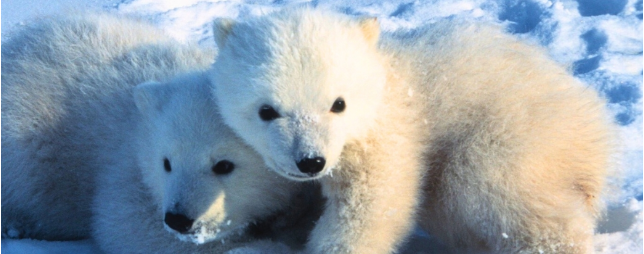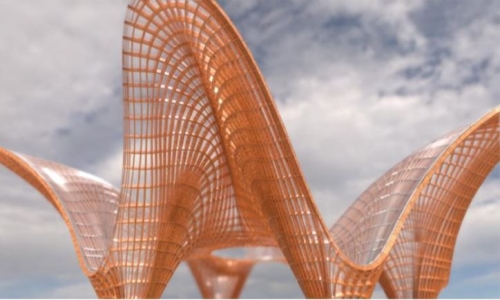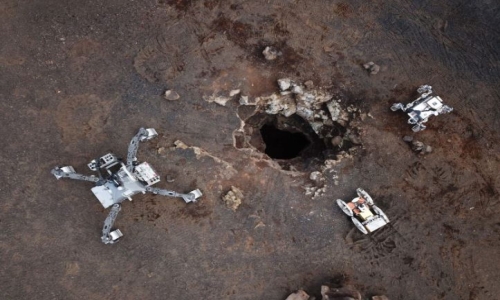


 8:42:5
8:42:5  2025-03-02
2025-03-02  1017
1017

Remote cameras in Norway have given us the first detailed look at polar bear cubs emerging from their dens, in videos more than 10 years in the making.
The first months of a polar bear (Ursus maritimus) cub's life are spent in a den of ice, where the warm bodies of their mother and siblings protect their initially hairless body from the lethal Arctic winter.
From a tiny half-kilogram (1 pound) at birth, the cubs grow quickly off their mother's milk and, as the season shifts, a supplement of seal blubber.
This approach helps the cubs to reach about 10 kilograms by the time they leave the den in the spring of their first year. The family will often den again the following winter, seeing the cubs through to weaning.
Shelter, in these vulnerable winter months, is crucial for cub survival in the first two years. Even then, less than half of the cubs that are born make it to adulthood.
Concealed within the remote, blinding-white landscapes of the Arctic, mothers give their cubs the best chance by digging dens under snow up to a few meters deep.
These have just two openings: one scraped in the ceiling for ventilation, the other a doorway that the cubs will cross only once the weather warms.
This strategy is so effective, it's made observation difficult for scientists hoping to map out the best protections for polar bear dens.
An international team of researchers fitted female polar bears with GPS satellite collars, enabling them to track mother bears to their dens in Svalbard's remote mountains.
Even with time-lapse cameras set up at 13 dens across six years (2016–2020 and 2023), footage of mothers with cubs is scant.
"As the data from satellite radio collars were available for all the mothers, the observational data made it possible to tell how changes in activity and temperature recorded correspond with behavior," says polar bear ecologist Jon Aars from the Norwegian Polar Institute.
The Svalbard polar bear families emerged from their dens around March 9th, and abandoned them earlier than has been previously recorded for this population. Further monitoring will reveal if this is a trend.
Shorter den time could be detrimental to cubs, who, without the chance to develop fully, may struggle to cope with the harsh environment they face outside.
Collar and camera data showed that after emerging from their dens, polar bears continued to live in and around it for an average of 12 days before setting off for the spring sea ice, though the duration varied greatly between families.
Some mothers were also recorded moving their family to a different den.
"Every den we monitored had its own story; every data point adds to our understanding of this crucial time and supports more effective conservation strategies," says lead author Louise Archer, an ecologist from the University of Toronto Scarborough.
The team also found cubs rely on their mothers heavily in these early years: they rarely ventured out of the den alone, and were seen without their mothers only 5 percent of the time.
Here, we see a mother bear guide three cubs out of their cozy den.
"Polar bear mothers are having increasing difficulties reproducing due to climate-driven changes, and are likely to face further challenges with the expansion of the human footprint in the Arctic," Archer says.
In an era of climate change and industrial expansion in the Arctic, the team hopes video studies like this one can help us to better understand how to protect this elusive species.
"Protecting denning habitats is essential for population health, and this study provides invaluable insights that will help guide protective management," conservation biologist Megan Owen from San Diego Zoo Wildlife Alliance adds.
Reality Of Islam |
|

A new NURBS

A research

Researchers
 9:3:43
9:3:43
 2018-11-05
2018-11-05
10 benefits of Marriage in Islam
 7:5:22
7:5:22
 2019-04-08
2019-04-08
benefits of reciting surat yunus, hud &
 9:45:7
9:45:7
 2018-12-24
2018-12-24
advantages & disadvantages of divorce
 11:35:12
11:35:12
 2018-06-10
2018-06-10
 6:0:51
6:0:51
 2018-10-16
2018-10-16
 5:57:34
5:57:34
 2023-03-18
2023-03-18
 4:25:57
4:25:57
 2023-02-11
2023-02-11
 8:3:0
8:3:0
 2018-06-21
2018-06-21
 1:34:8
1:34:8
 2022-02-01
2022-02-01
 6:14:3
6:14:3
 2023-01-18
2023-01-18
 1:38:41
1:38:41
 2021-12-08
2021-12-08
 7:32:24
7:32:24
 2022-02-14
2022-02-14
 5:41:46
5:41:46
 2023-03-18
2023-03-18
| LATEST |